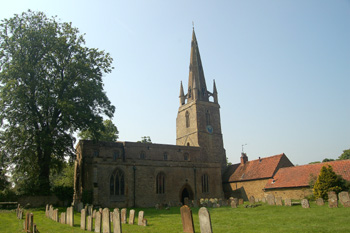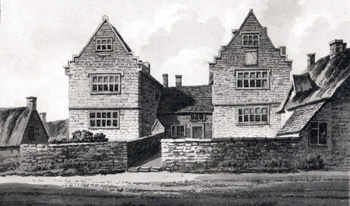Crime in Harrold
Volume XLI of the Bedfordshire Historical Records Society publications is a translation, by R.F.Hunnisett, of medieval coroner’s rolls for the county (the originals are held by The National Archives at Kew). Two entries detail crime in Harrold.

Harrold church from the north, May 2008
Theft
Entry 121 is very unusual for a coroner's roll as it does not deal with a death or with treasure trove, it reads: "On 12th March 1271 Thomas of Leicester, a thief, came to Harrold and about vespers [dusk] he came to Reynold de le Schaler's house, broke in, stole a surcoat of burnet, two sets of linen cloths and a sheet, was captured with the mainour and imprisoned in Ralph Morin's courtyard. On 2nd April he escaped from his prison, fled to Harrold church, stayed there until 8th April and then confessed before G.Rodlond and four townships that he had committed the said theft and others and was unwilling to surrender to the king's peace. He therefore abjured the realm according to the custom of England and was given the port of Dover". Abjuring the realm meant that he went into exile, he had to travel by the most convenient road to an appointed port, in this case Dover, and leave, if he did this he was safe, if he strayed from the road or refused to leave he would be tried.

The Old Manor - possibly built on the site of Ralph Morin's house [ref: Z49/257]
Murder
More sinister is Entry 287 which reads: "Inquest at Chellington before the same coroner [William Mordaunt] by Chellington with Carlton, Harrold, Odell and Turvey. On 24th May 1317 William of Thurlby was walking in Dungee in Harrold field and there met Thomas Crykhole, assaulted him, struck him on the head on the right ear with a "Bal[st]af" and afterwards cut his tongue with a knife. Thomas recovered, went from Dungee to Cogswell and there died. William immediately fled. J. de la Hay, sheriff of Bedfordshire, was therefore ordered to attach [him]. John Edward and Richard Daunger went to Cogswell and there found Thomas dead and removed him to Chellington before the coroner's arrival. [John and Richard were immediately arrested, delivered to the said sheriff and] were attached…" At the eyre it was said that Thomas Crilhole died immediately after the attack and it was ordered that William, described as John of Pavenham's hayward, be outlawed.

Dungee Farm in June 2008
Poaching
Serious crime was not restricted to the Middle Ages. Here is an article on poaching from the Bedfordshire Times of 20th December 1846. "A conflict of a somewhat serious nature took place on the night of Thursday week, between some of the gamekeepers to Major Magenis, of Harrold, and three poachers, who were found armed with guns in Dungee Wood for the purpose of destroying game. After a short but severe struggle, two of the poachers got away, and the other was captured. His name was James Westley, a labourer of Hinwick. Information was given to the police, who succeeded in apprehending one of the parties who escaped, but the other eluded their vigilance. The man's name who was apprehended is James Meadows, that of the man who absconded is John Petit. They were both labourers belonging to Hinwick. Meadows and Westley were taken before the magistrates on the following day, and were fully committed to take their trials for night poaching. They also stand remanded for further examination on a charge of felony".
The Gaol Database reveals that the three men had all been in trouble before, together and separately. James Westley was imprisoned on two separate occasions. On 7th March 1846 he was committed to Bedford New House of Correction for one calendar month's hard labour in the mill [i.e. walking the tread mill] for a "felony" committed with Meadows and Pettit. He was then 25 years of age and described as 5 feet 5 inches tall, with dark hair, hazel eyes and a fresh complexion. He had a stout build and a scar on the back of his left hand. He seems to have escaped punishment for this offence as he was not then imprisoned until 25th May 1852 when he paid a seven day visit to the County Gaol for "On 11th May inst at Podington unlawfully resisting Samuel Haynes a Police constable whilst in the execution of his duty", by now he had a scar on his right cheek, too.
The Gaol Database reveals that James Meadows was something of a gaol-bird. He was first committed, to Bedford New House of Correction, on 19th March 1844, aged 22, for Game Law offences - i.e. poaching. He served three months hard labour in the mill. He was described as being 5 feet 10¾ inches tall, with light brown hair, blue eyes and a stout build, he had a scar on his top lip and one each forefinger. He was again committed to Bedford House of Correction on 7th March 1846 (along with Westley and Pettit) for one calendar month's hard labour in the mill. For the offence outlined by the newspaper he was committed on 4th September 1847 to six months' hard labour in the same mill. However, he was discharged on 15th October that year. During his incarceration his behaviour was recorded as "good". He had been acquitted on a charge of poaching in 1845.
The Database reveals that John Pettit was also a gaol bird. He was first imprisoned, with Meadows and Westley, on 7th March 1846 for six calendar months' hard labour in the mill at Bedford New House of Correction for a "felony", with Meadows and Westley, he was then 30 years of age. He was described as 5 feet 3 inches in height, with light hair and hazel eyes. He could neither read nor write and came originally from Billing in Northamptonshire. He managed to evade arrest for his poaching expedition but was back in trouble in 1851: "On 18th May last at Podington breaking and stealing a quantity of pales forming part of a fence the property of R.L.Orlebar Esquire". Incidentally, his birth town was mistakenly described as Billington in Bedfordshire in this entry, but it is clearly the same man. He was committed on 16th June to three weeks' hard labour in the House of Correction. Finally, he was committed to the House of Correction again, for fourteen days' hard labour, on 3rd March 1853, he was evidently up to his old tricks: "On 1st January 1853 at Podington unlawfully breaking rails with intent to steal the same". By now he had learnt to "read imperfectly".
Animal Cruelty - a very unpleasant and graphic description not to be read by those of a sensitive disposition
These men were clearly rough and ready but their crimes are, to some extent, nothing out of the ordinary. A rather more unpleasant crime was committed by four young women from Harrold and Odell as the Bedfordshire Times of 11th March 1848 reveals: "GROSS SUPERSTITION AND REVOLTING ACT OF CRUELTY. Within these few days the county police have brought to light a circumstance, revolting in its details, which speaks little for the advancement of intelligence and the beneficial effects of education, in at least one part of Bedfordshire. The more remarkable, as well as deplorable, too, it appears when the fact is stated, that greater efforts for the enlightenment, the moral improvement, and the general benefit, of the youthful portion of a village is hardly made any where than in Harrold. The facts of the case alluded to are these: - Some nine or ten weeks ago, a female of Harrold, about twenty years of age, belonging to a humble class of life, fancied that a young man, of a similar station in life, of whom she appears to be passionately fond, did not pay her that attention which he used formerly to do. Like Candida of old who prepared her amoris peculum for the inconstant Varus, she was determined to try some 'art magical' to regain his favour, if not affections. For that purpose she conceived the preposterous idea that if she took out the heart of a cat while the animal was alive, stuck it full of pins, and buried it in the ground, the potent charm would excite the love of her 'John' towards her again. On an ominous night about the commencement of the present year she, with three other females, whose ages varied seventeen to twenty-five years, procured a cat and, at the House of one of the women at Odell, proceeded to put their superstitious and barbarous act into execution. While three of them held the poor animal, the fourth ripped it open with a pair of scissors, and took out its heart while the animal was alive. They then despatched it in a manner too revolting to describe. The animal's heart was then stuck full of pins, and actually buried in the garden by the deluded women. Need we, after this, wonder that in the form of the commission of Justices of the Peace the following words should still be retained? "We have also assigned you to inquire into the truth more fully of all manner of poisonings, inchantments, sorceries, arts, magic, &c." Since the affair was brought to light the females have manifested deep compunction for their foolish and revolting deed, and three of them have been sent to prison, as will be seen by our petty sessional report, to reflect on the consequences of giving way to such detestable notions, the other one having been admitted to give evidence".
The Gaol Database gives details of the three women imprisoned, the first two for seven days' hard labour, the last for fourteen days, in Bedford New House of Correction, mending prison linen. They were: Jane Matthews, aged 19, 5 feet 1½ inches tall, with brown hair and eyes, a lace maker from Harrold; Sarah Page, aged 26, 5 feet 4½ inches tall, with dark brown hair and brown eyes, a lace maker from Odell; and Mary Brice, aged 20, 5 feet tall, with dark brown hair and brown eyes, "good looking", a lace maker from, Harrold. The last is, presumably, the Candida referred to in the newspaper report.